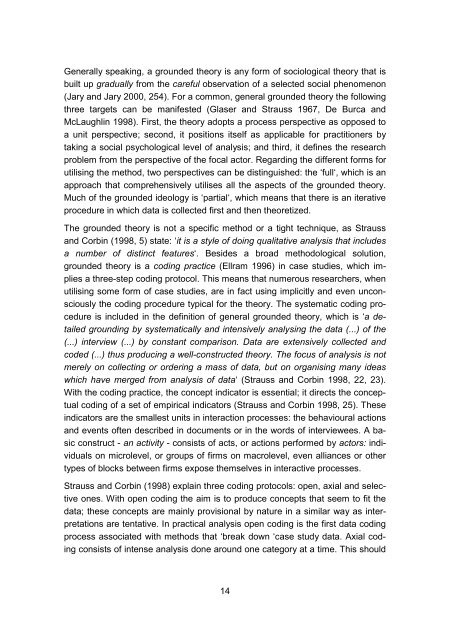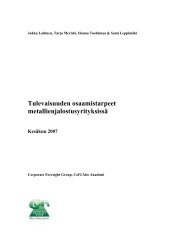849954 sisus
849954 sisus
849954 sisus
You also want an ePaper? Increase the reach of your titles
YUMPU automatically turns print PDFs into web optimized ePapers that Google loves.
Generally speaking, a grounded theory is any form of sociological theory that is<br />
built up gradually from the careful observation of a selected social phenomenon<br />
(Jary and Jary 2000, 254). For a common, general grounded theory the following<br />
three targets can be manifested (Glaser and Strauss 1967, De Burca and<br />
McLaughlin 1998). First, the theory adopts a process perspective as opposed to<br />
a unit perspective; second, it positions itself as applicable for practitioners by<br />
taking a social psychological level of analysis; and third, it defines the research<br />
problem from the perspective of the focal actor. Regarding the different forms for<br />
utilising the method, two perspectives can be distinguished: the ‘full‘, which is an<br />
approach that comprehensively utilises all the aspects of the grounded theory.<br />
Much of the grounded ideology is ‘partial‘, which means that there is an iterative<br />
procedure in which data is collected first and then theoretized.<br />
The grounded theory is not a specific method or a tight technique, as Strauss<br />
and Corbin (1998, 5) state: ‘it is a style of doing qualitative analysis that includes<br />
a number of distinct features‘. Besides a broad methodological solution,<br />
grounded theory is a coding practice (Ellram 1996) in case studies, which implies<br />
a three-step coding protocol. This means that numerous researchers, when<br />
utilising some form of case studies, are in fact using implicitly and even unconsciously<br />
the coding procedure typical for the theory. The systematic coding procedure<br />
is included in the definition of general grounded theory, which is ‘a detailed<br />
grounding by systematically and intensively analysing the data (...) of the<br />
(...) interview (...) by constant comparison. Data are extensively collected and<br />
coded (...) thus producing a well-constructed theory. The focus of analysis is not<br />
merely on collecting or ordering a mass of data, but on organising many ideas<br />
which have merged from analysis of data‘ (Strauss and Corbin 1998, 22, 23).<br />
With the coding practice, the concept indicator is essential; it directs the conceptual<br />
coding of a set of empirical indicators (Strauss and Corbin 1998, 25). These<br />
indicators are the smallest units in interaction processes: the behavioural actions<br />
and events often described in documents or in the words of interviewees. A basic<br />
construct - an activity - consists of acts, or actions performed by actors: individuals<br />
on microlevel, or groups of firms on macrolevel, even alliances or other<br />
types of blocks between firms expose themselves in interactive processes.<br />
Strauss and Corbin (1998) explain three coding protocols: open, axial and selective<br />
ones. With open coding the aim is to produce concepts that seem to fit the<br />
data; these concepts are mainly provisional by nature in a similar way as interpretations<br />
are tentative. In practical analysis open coding is the first data coding<br />
process associated with methods that ‘break down ‘case study data. Axial coding<br />
consists of intense analysis done around one category at a time. This should<br />
14








